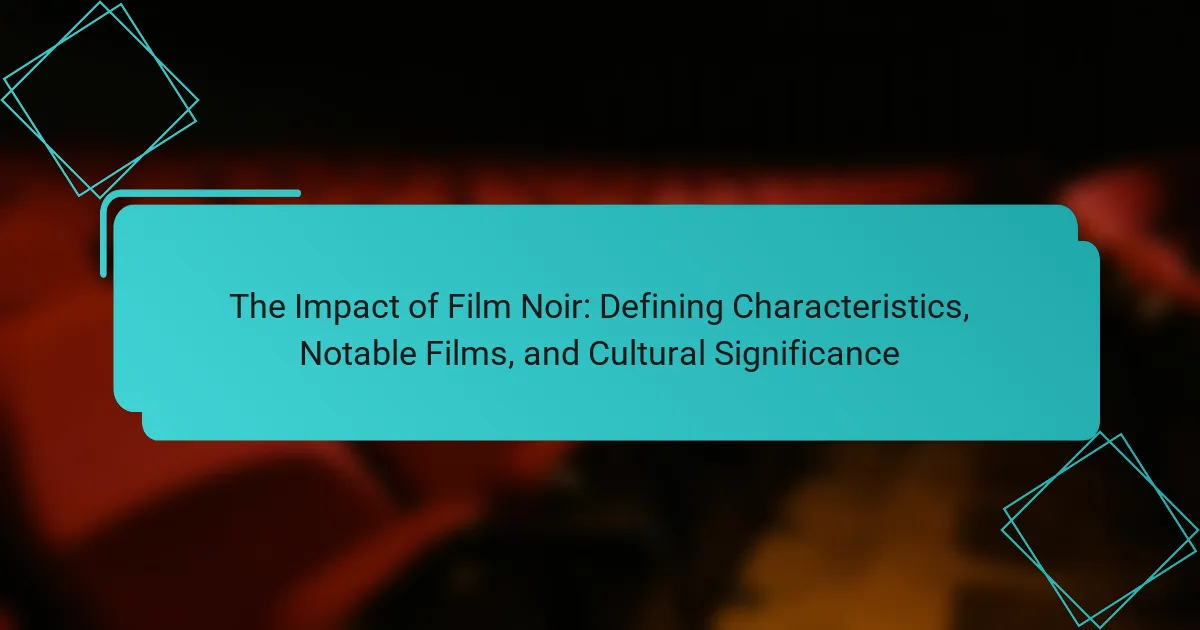Film Noir is a cinematic genre known for its dark themes, moral ambiguity, and stylized visuals, emerging in the early 1940s. Influenced by German Expressionism and post-World War II disillusionment, it features low-key lighting, complex narratives, and anti-hero protagonists. Notable films such as “Double Indemnity,” “The Maltese Falcon,” and “Sunset Boulevard” exemplify the genre’s characteristics while reflecting societal anxieties. Film Noir has significantly impacted popular culture, influencing various media and introducing archetypes like the femme fatale and hard-boiled detective, which continue to shape contemporary storytelling.

What is Film Noir and How Did It Emerge?
Film Noir is a cinematic genre characterized by its dark themes, moral ambiguity, and stylized visuals. It emerged in the early 1940s, influenced by German Expressionism and post-World War II disillusionment. The genre is marked by its use of low-key lighting, complex narratives, and anti-hero protagonists. Notable films include “Double Indemnity” (1944) and “The Maltese Falcon” (1941). Film Noir reflects societal anxieties and the darker aspects of human nature. Its emergence coincided with a shift in American culture, as audiences sought stories that mirrored their fears and uncertainties. The genre has since influenced numerous filmmakers and continues to resonate in modern cinema.
What are the defining characteristics of Film Noir?
Film Noir is characterized by its dark, cynical tone and moral ambiguity. It often features a flawed protagonist, typically a detective or anti-hero. The visual style includes low-key lighting and high contrast, creating a sense of tension. Narratives often revolve around crime, betrayal, and existential despair. Femme fatales are common, embodying danger and seduction. The settings frequently depict urban landscapes, emphasizing isolation. Themes of fate and doom are prevalent, reflecting post-war disillusionment. These characteristics have defined the genre since its emergence in the 1940s.
How do visual styles contribute to the Film Noir aesthetic?
Visual styles significantly contribute to the Film Noir aesthetic through the use of low-key lighting and high-contrast imagery. These techniques create a sense of mystery and tension, essential to the genre. Shadows play a crucial role in establishing mood and character, often obscuring motives and intentions. Additionally, the use of unusual camera angles enhances the feeling of disorientation. Tight framing emphasizes the psychological states of characters, reflecting their internal struggles. The stark black-and-white palette reinforces themes of moral ambiguity and existential despair. Historical context shows that these visual styles emerged during the post-World War II era, reflecting societal anxieties. Overall, the visual elements of Film Noir are integral to its narrative and thematic impact.
What themes are commonly explored in Film Noir films?
Common themes in Film Noir films include moral ambiguity, existential despair, and the dangers of obsession. These films often feature protagonists who are flawed and face ethical dilemmas. The narrative typically revolves around crime, betrayal, and the darker aspects of human nature. Women in Film Noir are often portrayed as femme fatales, embodying both allure and danger. The visual style emphasizes shadows, low-key lighting, and urban settings, enhancing the themes of isolation and paranoia. The genre reflects post-World War II disillusionment, showcasing a society grappling with corruption and loss of innocence.
Why is Film Noir considered a significant genre in cinema?
Film Noir is considered a significant genre in cinema due to its unique visual style and thematic depth. It emerged in the 1940s and 1950s, reflecting post-war American society’s anxieties. The genre is characterized by its use of low-key lighting, stark contrasts, and urban settings. It often features morally ambiguous characters and complex narratives. Film Noir explores themes of existentialism, crime, and human psychology. Notable films like “Double Indemnity” and “The Maltese Falcon” exemplify these traits. Critics and scholars recognize Film Noir for its influence on later genres and its artistic innovations. Its legacy continues to shape contemporary filmmaking and storytelling.
What cultural and historical contexts influenced the development of Film Noir?
Film Noir emerged from a complex interplay of cultural and historical contexts. The aftermath of World War II significantly shaped its themes. Soldiers returning home faced disillusionment and uncertainty. This societal mood found expression in the dark, cynical narratives of Film Noir. The rise of urbanization also played a crucial role. As cities grew, crime and corruption became prevalent, reflecting the gritty realities of postwar life.
Additionally, the influence of German Expressionism is evident in Film Noir’s visual style. Techniques such as chiaroscuro lighting and distorted perspectives were adopted from this earlier movement. The socio-political climate of the 1940s and 1950s contributed to the genre’s development. Issues like gender roles and moral ambiguity were explored in the context of changing societal norms.
Cinematic techniques, such as voice-over narration and flashbacks, also emerged during this period. These methods enhanced the storytelling and aligned with the genre’s themes of fate and existentialism. Overall, Film Noir is a product of its time, deeply rooted in the cultural and historical landscape of mid-20th century America.
How did Film Noir reflect societal issues of its time?
Film Noir reflected societal issues of its time by illustrating themes of moral ambiguity and existential despair. It emerged in the aftermath of World War II, reflecting disillusionment and anxiety prevalent in society. The characters often depicted a struggle against corrupt systems and a loss of faith in the American Dream. Films like “Double Indemnity” and “The Maltese Falcon” showcased femme fatales and hard-boiled detectives, representing gender roles and power dynamics. The use of shadowy cinematography emphasized the bleakness of urban life. Additionally, the narratives often involved crime and betrayal, mirroring societal fears of instability and mistrust. The genre served as a critique of postwar American values, highlighting issues such as economic disparity and moral decay.

What are Some Notable Films in the Film Noir Genre?
Notable films in the film noir genre include “Double Indemnity,” “The Maltese Falcon,” and “Sunset Boulevard.” “Double Indemnity,” released in 1944, is a classic example of noir with its themes of betrayal and murder. “The Maltese Falcon,” from 1941, features a complex plot and iconic characters. “Sunset Boulevard,” released in 1950, explores the darker side of Hollywood and fame. Other significant films include “Chinatown,” “The Big Sleep,” and “Out of the Past.” Each of these films showcases the genre’s characteristic visual style and moral ambiguity.
Which films are considered classics of Film Noir?
Classic films of Film Noir include “The Maltese Falcon,” “Double Indemnity,” and “Sunset Boulevard.” “The Maltese Falcon,” released in 1941, is often regarded as the first major film noir. “Double Indemnity,” directed by Billy Wilder in 1944, exemplifies the genre’s themes of betrayal and moral ambiguity. “Sunset Boulevard,” also from 1950, showcases the darker side of Hollywood and features iconic noir elements. Other notable classics are “Laura,” “The Big Sleep,” and “Out of the Past.” These films are characterized by their use of shadowy cinematography, complex characters, and intricate plots.
What makes ‘Double Indemnity’ a quintessential Film Noir?
‘Double Indemnity’ is a quintessential Film Noir due to its dark themes, moral ambiguity, and stylistic elements. The film features a complex narrative centered around betrayal and greed. It includes a femme fatale character who manipulates the male protagonist. The use of low-key lighting creates a shadowy atmosphere typical of Film Noir. Additionally, the dialogue is sharp and filled with cynicism, reflecting the genre’s characteristic tone. The film’s plot revolves around insurance fraud, showcasing the darker side of human nature. ‘Double Indemnity’ is often cited as a defining example of the genre, influencing countless films that followed. Its critical acclaim includes nominations for seven Academy Awards, solidifying its place in cinematic history.
How did ‘The Maltese Falcon’ shape the Film Noir genre?
‘The Maltese Falcon’ defined key elements of the Film Noir genre. It introduced a morally ambiguous protagonist, Sam Spade, who exemplifies the flawed detective archetype. The film’s use of low-key lighting and shadowy cinematography set a visual standard for noir aesthetics. Its complex narrative structure, featuring twists and deception, became a hallmark of the genre. The character dynamics showcased betrayal and greed, reinforcing noir’s themes of existentialism and moral ambiguity. Released in 1941, it influenced subsequent films like ‘Double Indemnity’ and ‘The Big Sleep’. Critics have noted its lasting impact on the portrayal of crime and the anti-hero in cinema.
What are the contributions of modern films to the Film Noir legacy?
Modern films contribute to the Film Noir legacy by incorporating its stylistic elements and themes. They often feature morally ambiguous characters similar to classic noir protagonists. The use of chiaroscuro lighting is prevalent in many contemporary thrillers, evoking the visual style of classic noir. Additionally, modern narratives frequently explore themes of crime, betrayal, and existential despair. Films like “Sin City” and “Drive” exemplify these noir characteristics. They pay homage to the genre while updating it for contemporary audiences. This blend of old and new keeps the Film Noir legacy alive and relevant.
How do contemporary filmmakers incorporate Film Noir elements?
Contemporary filmmakers incorporate Film Noir elements through visual style, narrative structure, and character archetypes. They often use high-contrast lighting and shadows to create a moody atmosphere. This technique evokes the classic Film Noir aesthetic. Non-linear storytelling is frequently employed to build suspense and complexity. Filmmakers include morally ambiguous protagonists who navigate a corrupt world. Femme fatales are also a common character type, embodying danger and allure. The themes of existentialism and fatalism persist in modern narratives, reflecting contemporary societal issues. Films like “Sin City” and “Blade Runner 2049” exemplify these techniques, showcasing the enduring influence of Film Noir.
What are some examples of neo-noir films and their significance?
Some examples of neo-noir films include “Blade Runner,” “Chinatown,” and “The Usual Suspects.” These films are significant for their modern reinterpretation of classic film noir themes. “Blade Runner” explores existential questions and the nature of humanity in a dystopian future. “Chinatown” delves into corruption and moral ambiguity in 1970s Los Angeles. “The Usual Suspects” features a complex narrative structure and unreliable storytelling. Each film revitalizes noir aesthetics while addressing contemporary societal issues. These examples highlight the continued relevance and evolution of noir in cinema.

How Has Film Noir Influenced Popular Culture?
Film noir has significantly influenced popular culture through its distinctive visual style and thematic elements. The genre introduced a unique blend of cynicism and moral ambiguity. These traits have been adopted in various media, including literature, television, and graphic novels. Iconic film noir elements, such as shadowy lighting and urban settings, can be seen in modern thrillers and crime dramas. Additionally, film noir’s archetypes, like the femme fatale and hard-boiled detective, continue to inspire character development across genres. The genre’s impact is evident in contemporary films that pay homage to its stylistic and narrative techniques. For example, movies like “Blade Runner” and “Sin City” reflect film noir aesthetics and themes. Overall, film noir’s legacy endures, shaping the storytelling landscape in popular culture.
What impact has Film Noir had on other film genres?
Film Noir has significantly influenced various film genres, particularly crime, thriller, and neo-noir. Its stylistic elements, such as low-key lighting and urban settings, have become staples in these genres. The moral ambiguity present in Film Noir has shaped character development in thrillers and crime dramas. Iconic narrative techniques, like flashbacks and unreliable narrators, were popularized by Film Noir, impacting modern storytelling.
Additionally, the themes of existentialism and cynicism found in Film Noir resonate in contemporary films, creating a lasting legacy. Films like “Chinatown” and “Blade Runner” exemplify this influence by incorporating noir aesthetics and themes. The impact of Film Noir extends beyond cinema, influencing literature and visual arts, showcasing its broad cultural significance.
How has Film Noir influenced the thriller and crime genres?
Film Noir has significantly influenced the thriller and crime genres through its stylistic elements and thematic depth. It introduced a darker, more cynical tone that permeates modern thrillers. The use of morally ambiguous characters became a staple in crime narratives. Additionally, Film Noir emphasized psychological tension and complex plots, which are now common in thrillers. The visual style, characterized by high contrast lighting and shadowy cinematography, set a precedent for visual storytelling in crime films. Classic Film Noir films like “Double Indemnity” and “The Maltese Falcon” established narrative structures that continue to inspire contemporary filmmakers. Its impact is evident in the works of directors like David Fincher and the Coen Brothers, who incorporate Noir elements into their narratives. Overall, Film Noir laid the groundwork for the evolution of suspense and crime storytelling in cinema.
What are the visual and narrative techniques borrowed from Film Noir in modern cinema?
Modern cinema borrows several visual and narrative techniques from Film Noir. Key visual elements include high-contrast lighting and deep shadows, creating a moody atmosphere. These techniques enhance the sense of mystery and tension in films. Additionally, the use of unusual camera angles and framing contributes to a feeling of unease.
Narratively, modern films often incorporate complex characters with moral ambiguity, reflecting the anti-hero archetype prevalent in classic Film Noir. The themes of betrayal, existential dread, and fatalism are also common in contemporary narratives.
Films like “Blade Runner” and “Sin City” exemplify these borrowed techniques. “Blade Runner” uses neon lighting and rain-soaked streets, reminiscent of classic Noir visuals. “Sin City” employs stark black-and-white contrast with splashes of color, echoing traditional Film Noir aesthetics.
These techniques demonstrate the lasting influence of Film Noir on modern storytelling and visual style in cinema.
What are some key takeaways for understanding Film Noir’s cultural significance?
Film Noir represents a critical cultural movement in cinema. It emerged in the 1940s and 1950s, reflecting post-war anxieties. This genre often portrays moral ambiguity and existential despair. The visual style features high contrast lighting and urban settings. Notable films like “The Maltese Falcon” and “Double Indemnity” exemplify these traits. Film Noir influences contemporary storytelling and visual aesthetics. Its themes resonate with societal issues, such as crime and corruption. The genre has shaped modern interpretations of heroism and villainy.
How can viewers better appreciate the nuances of Film Noir films?
Viewers can better appreciate the nuances of Film Noir films by understanding their defining characteristics. Film Noir is known for its distinctive visual style, often utilizing low-key lighting and stark contrasts. Viewers should pay attention to the themes of moral ambiguity and existential despair prevalent in these films. Recognizing the archetypal characters, like the femme fatale and the hardboiled detective, enhances understanding. Familiarity with the historical context of the post-World War II era can provide deeper insights into the narratives. Engaging with the sound design, including the use of jazz music, can also enrich appreciation. Analyzing the cinematography, such as the use of shadows and angles, reveals the filmmakers’ intentions. Observing the dialogue’s sharp wit and cynicism highlights the genre’s unique storytelling approach. Overall, a comprehensive exploration of these elements allows viewers to fully appreciate Film Noir’s complexities.
What resources are available for those wanting to explore Film Noir further?
Books on Film Noir offer in-depth analysis and historical context. “Film Noir: The Encyclopedia” by Paul Duncan is a comprehensive reference. “The Noir Style” by Michael E. Grost explores visual and thematic elements. Online databases like the Internet Movie Database (IMDb) provide film listings and reviews. Streaming platforms often feature curated Film Noir collections. Documentaries, such as “Film Noir: Bringing Darkness to Light,” provide insights into the genre’s development. Academic journals publish articles on Film Noir’s cultural significance. Film festivals sometimes showcase classic and contemporary Noir films, offering discussions and panels.
Film Noir is a cinematic genre known for its dark themes, moral ambiguity, and stylized visuals that emerged in the early 1940s. This article explores the defining characteristics of Film Noir, including its visual style, common themes, and notable films such as “Double Indemnity” and “The Maltese Falcon.” It also examines the cultural and historical contexts that influenced the genre’s development, its impact on popular culture, and its lasting legacy in modern cinema. Key takeaways highlight the significance of Film Noir in shaping contemporary storytelling and visual aesthetics.
